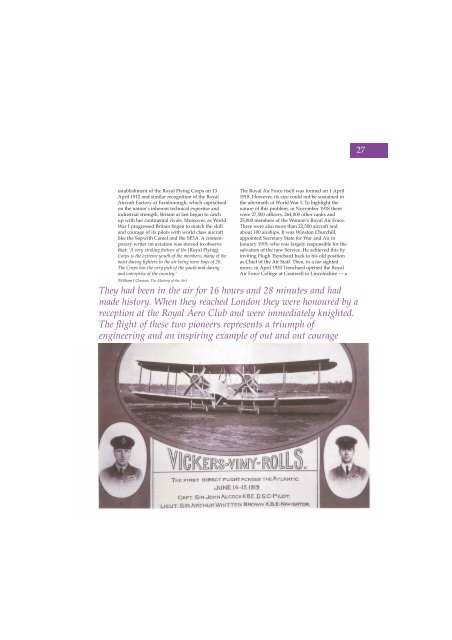Volume 6 No 4 - Royal Air Force Centre for Air Power Studies
Volume 6 No 4 - Royal Air Force Centre for Air Power Studies
Volume 6 No 4 - Royal Air Force Centre for Air Power Studies
Create successful ePaper yourself
Turn your PDF publications into a flip-book with our unique Google optimized e-Paper software.
27<br />
establishment of the <strong>Royal</strong> Flying Corps on 13<br />
April 1912 and similar recognition of the <strong>Royal</strong><br />
<strong>Air</strong>craft Factory at Farnborough, which capitalised<br />
on the nation’s inherent technical expertise and<br />
industrial strength, Britain at last began to catch<br />
up with her continental rivals. Moreover, as World<br />
War I progressed Britain began to match the skill<br />
and courage of its pilots with world class aircraft<br />
like the Sopwith Camel and the SE5A. A contemporary<br />
writer on aviation was moved to observe<br />
that: ‘A very striking feature of the [<strong>Royal</strong> Flying]<br />
Corps is the extreme youth of the members, many of the<br />
most daring fighters in the air being mere boys of 20.<br />
The Corps has the very pick of the youth and daring<br />
and enterprise of the country.’<br />
(William J Claxton, The Mastery of the <strong>Air</strong>)<br />
The <strong>Royal</strong> <strong>Air</strong> <strong>Force</strong> itself was <strong>for</strong>med on 1 April<br />
1918. However, its size could not be sustained in<br />
the aftermath of World War I. To highlight the<br />
nature of this problem, in <strong>No</strong>vember 1918 there<br />
were 27,500 officers, 264,000 other ranks and<br />
25,000 members of the Woman’s <strong>Royal</strong> <strong>Air</strong> <strong>Force</strong>.<br />
There were also more than 22,500 aircraft and<br />
about 100 airships. It was Winston Churchill,<br />
appointed Secretary State <strong>for</strong> War and <strong>Air</strong> in<br />
January 1919, who was largely responsible <strong>for</strong> the<br />
salvation of the new Service. He achieved this by<br />
inviting Hugh Trenchard back to his old position<br />
as Chief of the <strong>Air</strong> Staff. Then, in a far-sighted<br />
move, in April 1920 Trenchard opened the <strong>Royal</strong><br />
<strong>Air</strong> <strong>Force</strong> College at Cranwell in Lincolnshire — a<br />
They had been in the air <strong>for</strong> 16 hours and 28 minutes and had<br />
made history. When they reached London they were honoured by a<br />
reception at the <strong>Royal</strong> Aero Club and were immediately knighted.<br />
The flight of these two pioneers represents a triumph of<br />
engineering and an inspiring example of out and out courage
















